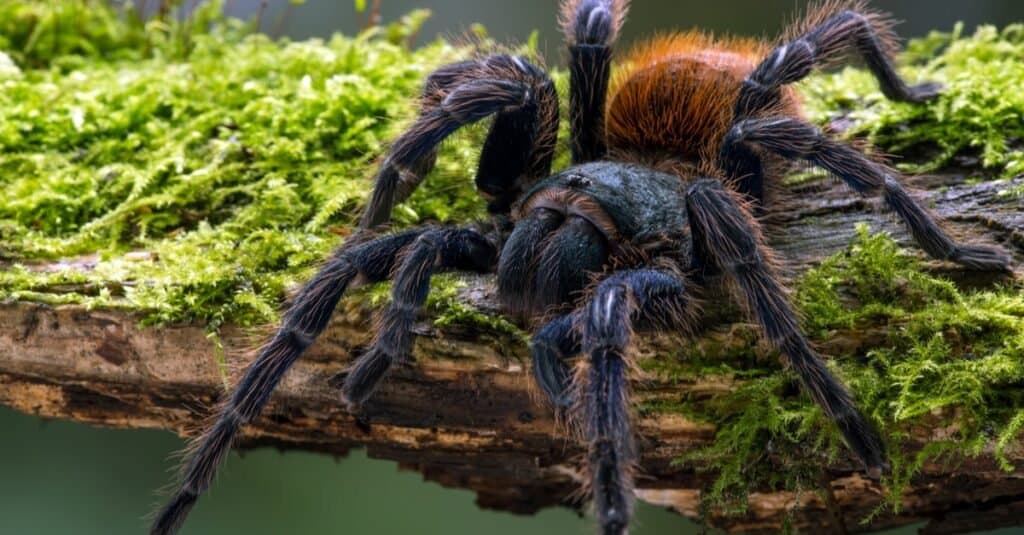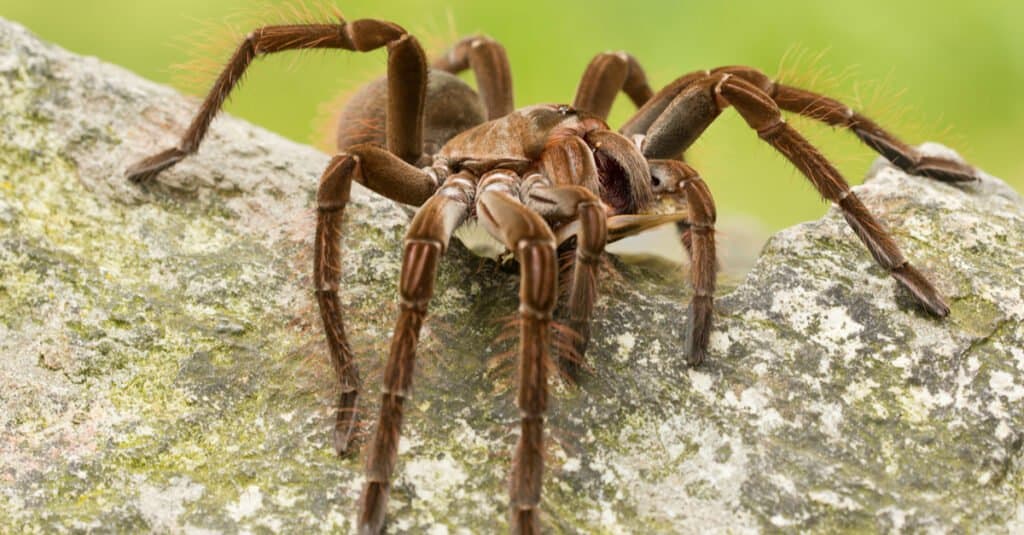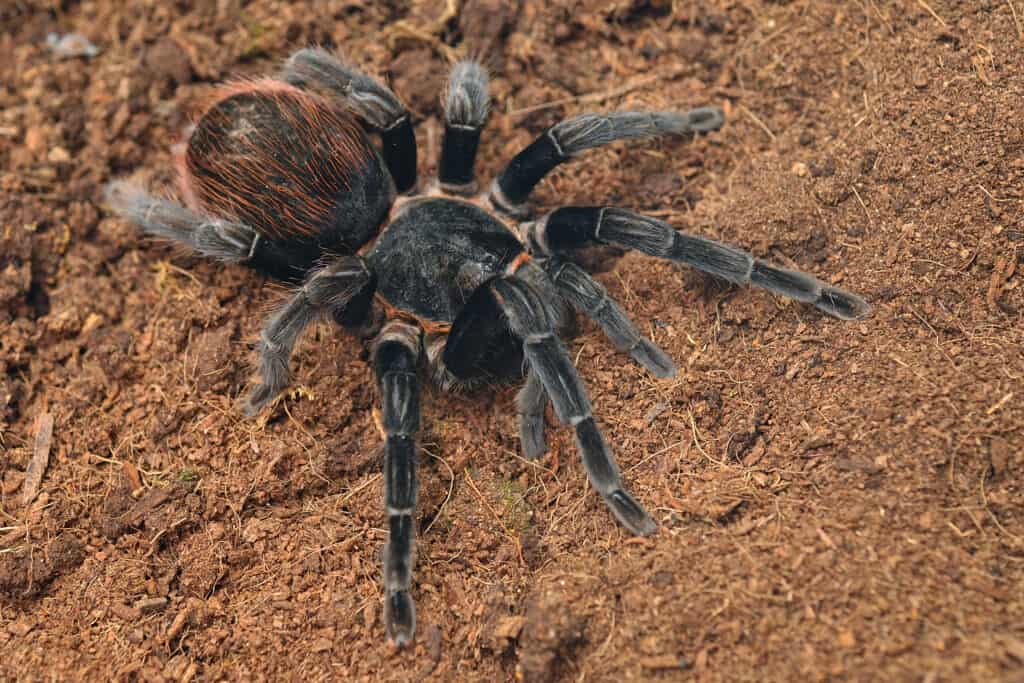When talking about dangerous and frightening spiders, tarantulas are always number one to come up. Countless films have depicted tarantulas as killer spiders and they are a Hollywood favorite when it comes to ‘experiments gone wrong’. Tarantulas are not as terrifying as those portrayed in films. In fact, tarantulas are highly skilled and are specially clever when it comes to hunting, catapulting them to the top of the food chain.
Despite its small size, the tarantula is an extremely adept spider that can take on any opponent, even those many times bigger than its size. Tarantulas are powerful apex predators because of their wit and impressive ability to adapt to a wide range of settings. It is unlikely that anyone will be able to stop tarantulas from hunting for food as they are natural experts in hunting and are opportunistic feeders. That leads us to the question, what do tarantulas eat?
What Do Tarantulas Eat?

As carnivores, tarantulas
eat insects
like crickets, beetles, caterpillars, and other spiders.
©iStock.com/Dan Olsen
Tarantulas are exclusive carnivores that eat a diet that includes huge insects like grasshoppers, crickets, beetles, caterpillars, other spiders, and sometimes even small lizards. Tarantulas bigger in size will also eat small rodents, frogs, birds, and sometimes even snakes.
They are one of the largest spider species in the world. Adult tarantulas usually measure 5 inches in length. The Goliath Bird Eating Spider, the second largest spider species on Earth, has an 11-inch leg span and weighs from 5 to 6 ounces. Tarantulas often eat prey that are smaller than their size, which means that the bigger the tarantula gets, the bigger its food is.
The Goliath Bird Eating Spider, for instance, is observed to eat small birds such as hummingbirds. Most tarantula species eat a variety of prey, depending on their size. Tarantulas are opportunistic feeders and expert hunters who will eat almost anything and everything they can.
A Complete List of Food Tarantulas Like to Eat
Tarantulas typically hunt during the night. As carnivores, they enjoy feeding on meat and will often try to hunt down any animal smaller than their size. Here is a complete list of food tarantulas often include in their diet:
- Grasshoppers
- Crickets
- Beetles
- Smaller spiders
- Arthropods
- Cicadas
- Caterpillars
- Millipedes
- Mealworms
- Superworms
- Roaches
- King worms
- Silkworms
- Hornworms
- Toads
- Frogs
- Fish
- Lizards
- Bats
- Pinky mice
- Rodents
- Small snake
- Birds
A tarantula’s diet usually consists of invertebrates, but larger tarantulas can feed on small vertebrates.
How Do Tarantulas Hunt for Food?

Tarantulas hunt for prey by relying on their extreme sensitivity to vibrations from the ground.
©davemhuntphotography/Shutterstock.com
As nocturnal hunters, tarantulas rely on their extreme sensitivity to vibrations from the ground that gives them signals to where to hunt for prey. Tarantulas often ambush their prey, catching them with a bite from their sharp fangs, called chelicerae, and releasing a venom that paralyzes them.
This bite creates a chemical-induced venom or digestive enzyme that can dissolve the prey’s meat. This chemical helps in liquefying the victim’s flesh, so the tarantula can suck the liquid up using its straw-shaped mouth under its fangs. Tarantulas are also equipped with powerful jaws that can disintegrate their victim.
Unlike most species of spiders who spin webs in order to trap their prey, tarantulas spend most of their time on the ground, burrowing under dry soil. They often line the walls of their burrow hole with silk which may serve as an alarm whenever a prey is near their home.
How Do Tarantulas Digest Their Food?
Tarantulas have a unique digestive system featuring a “sucking stomach”. This “sucking stomach” allows tarantulas to consume and digest fluids. Since they convert their prey’s flesh into liquid using their digestive enzyme, tarantulas use their sucking stomach to drain their liquefied prey up through their mouths and into their digestive systems by contracting the stomach’s strong muscles.
Intestinal walls inside the tarantula’s stomach break down large food particles into smaller fragments, which are then absorbed into the bloodstream. As a result of this mechanism, the nutrients are dispersed throughout the tarantula’s body and metabolized. The tarantula forms the prey’s carcass into a ball and disposes of it thereafter.
What Do Tarantulas Eat in Captivity?

In captivity, tarantulas eat mealworms, dubia roaches, and other invertebrates.
©Milan Zygmunt/Shutterstock.com
Tarantulas inside cages are still carnivores, so they need live food sources. The best choices of food for tarantulas in captivity are gut-loaded insects, mealworms, dubia roaches, crickets, and other invertebrates. Larger pet tarantulas can also be fed with small pinky mice, frozen or thawed.
Young tarantulas normally eat regularly, while adult ones can be fed every other day, but since they are nocturnal animals, they should still be fed during the night even inside cages. Tarantulas should be given only the amount of food that they can manage to eat, as live insects or other prey left uneaten inside their cages can cause harm to them. So it is best to remove unconsumed prey immediately within 10 minutes after feeding.
Giving water to pet tarantulas should also be done regularly. Placing huge amounts of water inside their enclosures can cause drowning, so it is best to give them small amounts and refill regularly. Tarantulas often rely on the moisture of plants in their surroundings, so a small bowl of water is more than enough.
| Food | |
|---|---|
| 1. | Grasshoppers |
| 2. | Crickets |
| 3. | Beetles |
| 4. | Smaller spiders |
| 5. | Arthropods |
| 6. | Cicadas |
| 7. | Caterpillars |
| 8. | Millipedes |
| 9. | Mealworms |
| 10. | Superworms |
| 11. | Roaches |
| 12. | King worms |
| 13. | Silkworms |
| 14. | Hornworms |
| 15. | Toads |
| 16. | Frogs |
| 17. | Fish |
| 18. | Lizards |
| 19. | Bats |
| 20. | Pinky mice |
| 21. | Rodents |
| 22. | Small snakes |
| 23. | Birds |
Do Tarantulas Bite Humans?
Tarantulas do not typically bite humans unless they feel threatened in any way. Their bite, however, is just as painful as a bee sting. Tarantulas also have urticating hairs located in their abdomen which they can release through kicking, as part of their defense mechanism against predators. These “flicks” can cause irritation and allergy when used against humans.
Who Eats Tarantulas?
Despite being powerful predators, tarantulas are also prey to many animals such as giant centipedes and even humans. The tarantula hawk, a large wasp species, is a tarantula’s main predator.
Female tarantula hawks actively hunt tarantulas, stinging them and paralyzing them. Once the tarantula is subdued by the wasp, it will be sealed up in its own burrow. The tarantula hawk will lay eggs on its back, and it will be a fresh source of meat once the wasp’s eggs hatch. Tarantula hawk larvae will feed on tarantulas for several weeks, eating them alive while they grow past their larvae stage!
Do Tarantulas Like Petting?

Mexican red rump tarantulas (
Brachypelma vagans) are thought to be more docile than others but they still prefer not to be touched.
©D. Kucharski K. Kucharska/Shutterstock.com
Tarantulas are not like your typical pet. Unlike cats and dogs, they generally do not like to be handled, held, or touched. It is said that tarantulas do not recognize their handlers and often consider people as threats, which increases the chance of you being bit. While most spiders do not have long lives, tarantulas can live upward of 20 years if they receive the proper care, they prefer to be left alone.
There are 1,040 species of tarantulas and on the whole, they are not thought to be aggressive. While some species may tolerate human touch better than others and are even more gentle and forgiving, like the Mexican red rump or the Mexican pink toe tarantula, every arachnid may be different, just like any animal, but it is thought best to let them be.
The photo featured at the top of this post is © James McKay/Shutterstock.com
Thank you for reading! Have some feedback for us? Contact the AZ Animals editorial team.






